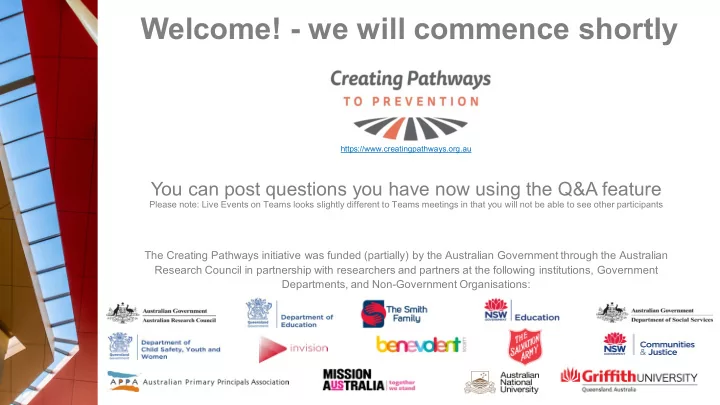

Welcome! - we will commence shortly https://www.creatingpathways.org.au You can post questions you have now using the Q&A feature Please note: Live Events on Teams looks slightly different to Teams meetings in that you will not be able to see other participants The Creating Pathways initiative was funded (partially) by the Australian Government through the Australian Research Council in partnership with researchers and partners at the following institutions, Government Departments, and Non-Government Organisations:
The Value of Measuring the Wellbeing of Community Partnerships Reviewing collaborative practice with the Coalition Wellbeing Survey Dr Kate Frieberg and Professor Ross Homel Griffith Criminology Institute Rosealie Vallance, Lydia McMillan, and Louise Collins YWCA Australia - Communities for Children Murwillumbah and Lismore
Outline • CREATE project background • Development of Coalition Wellbeing Survey (CWBS) • Use of CWBS in CREATE research design – findings from Phase 1 • Use of CWBS by Community Coalition • Q & A
The CREATE Project: A Play in Three Acts Phase 1: 2013-2016 – 10 CfC communities (5 + 5) Building the capacity to take collective impact to scale (Stage 1 of the Change Cycle) Phase 2: 2016-2018 – 22 CfC communities Establishment of the prevention support and data collection systems Phase 3: 2019-2020 – 22 CfC communities (9+13) Implementation: Stages 1, 2 & 3 of Change Cycle
Innovation without capacity is of limited value…
Community Services Shared Purpose and Safe Space for Government Community Respectful Relationships and Co- creation of Really Useful Science-based Tools, Methods and Resources Funders Researchers
CREATE Project Goal DEVELOP SUPPORT SYSTEM Facilitate change • In the way we work together • To achieve better outcomes for children
Collaboration as a strategy for achieving better outcomes for children
Collaborative Advantage The whole is greater than the sum of its parts
Some Characteristics of Effective Coalitions • Shared Vision and Goal Clarity • Respectful Relationships • Effective and Timely Communication • Role Clarity • Governance and Guidelines • Shared Responsibility and Accountability
CWBS Framework DOMAIN ASSETS ATTRIBUTES Indicators Clear purpose & shared goals 3 items Direction setting Strategic planning 4 items Working together 3 items COLLECTIVE PURPOSE Collaboration value 5 items Readiness to collaborate Role clarity 3 items (31 items) Commitment and cohesion 3 items Active participation 6 items Membership Characteristics 4 items Agreed guidelines 1 item Decision making 3 items Governance, principles, and procedures Conflict resolution 2 items COLLECTIVE PROCESS Structuring processes 2 items (24 items) Leadership 3 items Communication 4 items Engagement and Reciprocity Member benefits 4 items Principles of equity 5 items Reviewing progress 6 items COLLECTIVE RESPONSIBILITY Evidence-informed 5 items (13 items) Supporting good practice and process 2 items Collective efficacy COMMUNITY COHESION 5 items
CWBS Development Timeline CREATE PHASE 1 PHASE 2 2014 2015 2016 2017 Review empirical literature Implement T1 CWBS Implement T2 CWBS Develop online CWBS (10 CfC coalitions) (10 CfC coalitions) resource package - Research team collects data - Research team collects data Develop conceptual (Qualtrics) (Qualtrics) Self-service management framework - Research team and CIFs - Research team and CIFs dashboard for coalition leaders prepare reports and deliver prepare reports and deliver to: Develop survey questions to each coalition manager to each coalition manager Collect own data - Report own data - CIFs work actively with Action Analysis of T1-T2 change Use own data - site coalitions and passively (relative to project group) with BAU sites Factor analyse aggregate data Revise question set (reduce number of items)
Analyses of baseline data (Time 1) • N=150 respondents from 10 CfC communities and 11 coalitions • 5 ‘action sites’ where CIFs work with coalitions; 5 ‘business as usual’ sites (receive a report on their coalition, but no support) • Out of 92 key questions, 47 (51%) had > 30% missing values • Most common items not answered (> 60%): • The way decisions are made in the coalition • How often do you support the decisions made by the partnership? • How often do you feel that you have been left out of the decision- making process?
Variation across sites • Striking differences between sites • Sites with the most missing emerged as amongst ‘the healthiest’ in the factor analyses of coalition functioning (with missing items removed) • Suggests that negative views are suppressed through ‘no answer’ – impression management?
• All coalitions improved on most items: • 90% of items showed positive changes in the Action sites • 60% in the BAU sites showed positive change, with 31% negative changes 2
Maximum likelihood factor analysis in R, with oblique rotation • A 2-factor solution provided an adequate fit* • Clarity of collective purpose, direction and roles • Collaborative processes that enhance relationships and engagement • * (RMSE<.05)
2 2
But a 4-factor solution also provided an adequate fit and was more informative • Partnership valued and supported • Support for collaborative processes • Governance structures and procedural processes • Member perception of benefits gained through the partnership
2 2
NOTE There were too many missing values at Time 1 for the variables comprising F4 to show the change 2
Concluding remarks • All sites improved from Time 1 to Time 2 (the Time 1 reports were useful even without the support of CIFs) • Action sites started behind (at Time 1) • Action sites caught up by Time 2 (2016) • In the case of F3: governance structures, action sites performed better than BAU by Time 2. • Action sites tended to improve more on items directly related to the CREATE principles, while BAU sites tended to improve on aspects of organisational capacity (reflecting DSS resources) • We interpret this as evidence that the CIFs were effective as ‘critical friends and agents of change’
Voices from the field Rosealie Vallance – Partnership Coordinator Murwillumbah Lydia McMillan – Partnership Coordinator Lismore Louise Collins – Communities for Children Team Leader Communities for Children – YWCA Australia
Q&A
Recommend
More recommend